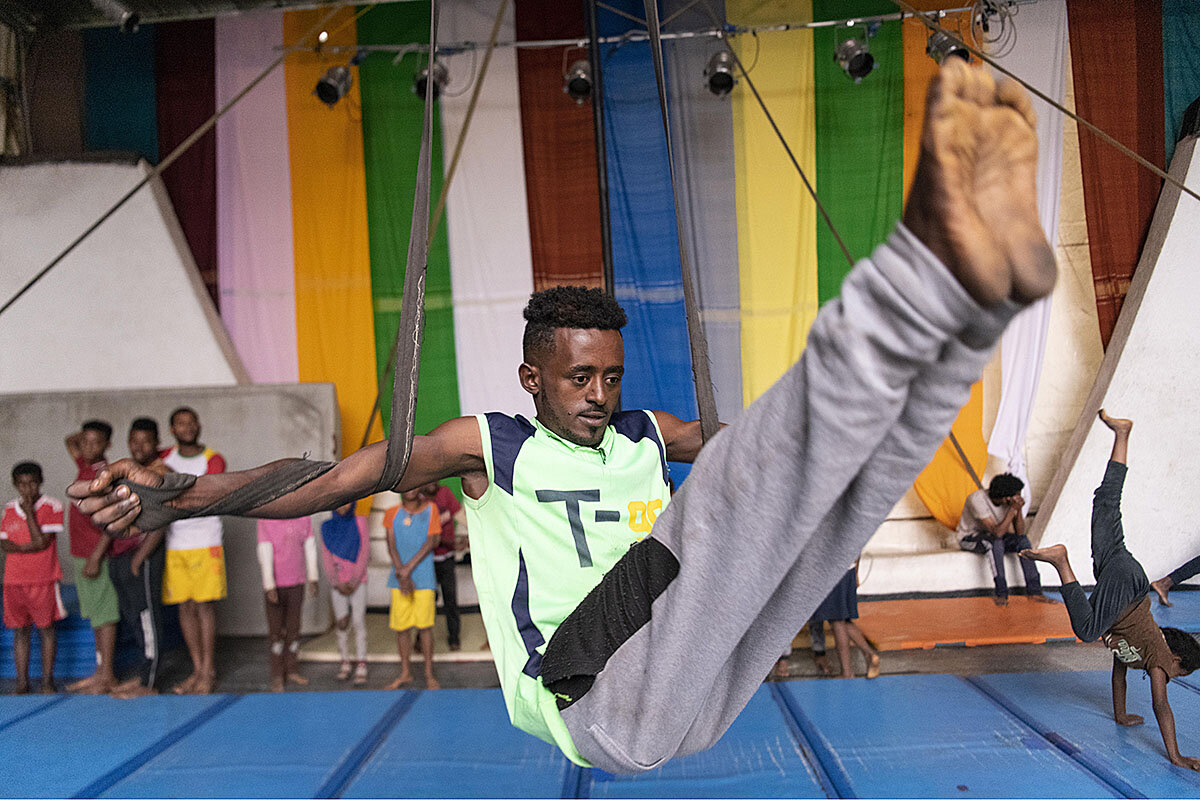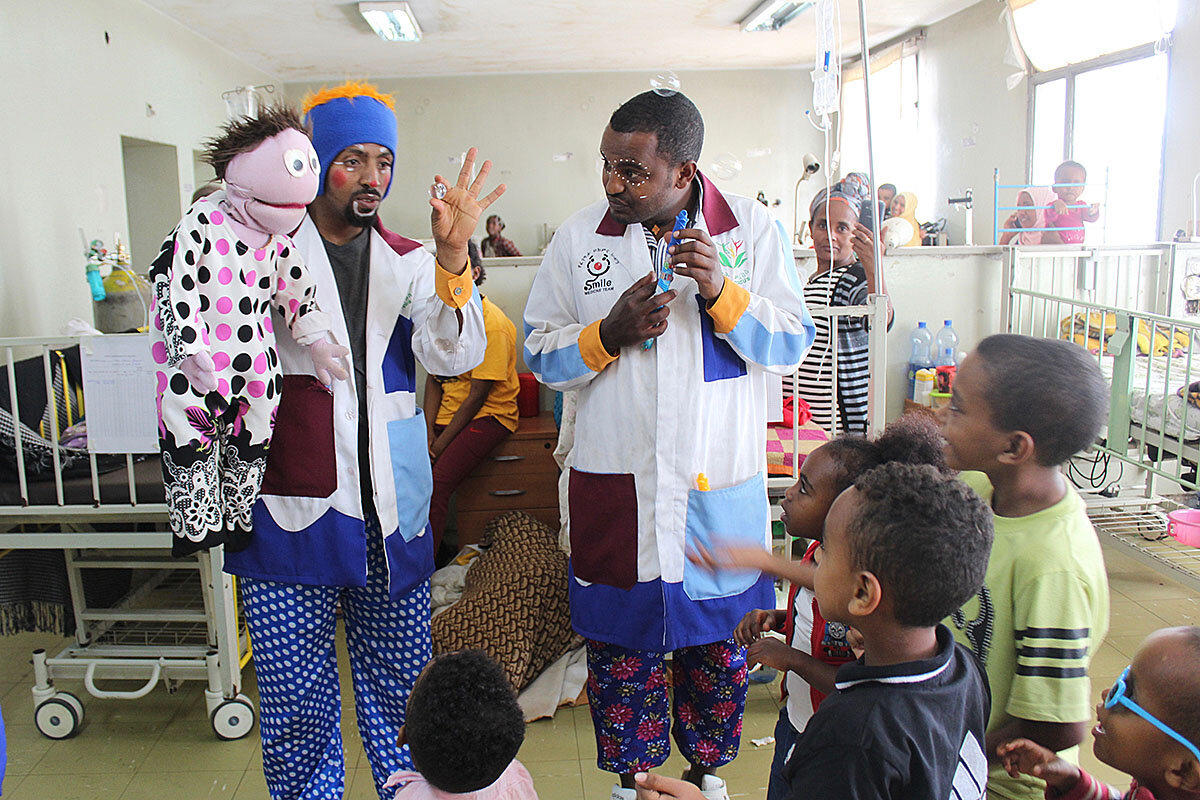Tumbling toward community: The ‘blossoming’ circus of Addis Ababa
Loading...
| Addis Ababa, Ethiopia
On a slate-colored April afternoon, Ethiopia’s capital is knee-deep in water. Rows of bug-eyed blue and white Soviet taxis slide slowly through the deluge, heaving a thick spray onto the sidewalks as all around them water bursts from the city’s seams, spilling out of clogged gutters and rushing through the cracks in walls and roofs and fences.
But down a steep cobbled street lined with bougainvillea, behind the aluminum-sheeted walls of a small compound, the show must go on.
As the rainstorm tap dances across the roof, two dozen children hop and tumble across a squishy blue mat, jumping and falling with all the precision of popping popcorn. “Good!” calls out an instructor. “Again!”
Every afternoon, whether the thin Addis air is dry or wet, the courtyard of Fekat Circus fills with children from the surrounding neighborhood, diving through hoops and flopping in and out of handstands as part of a daily crash course in the circus arts.
“For a lot of people, the circus is about escape,” says Dereje Dange, watching a string-beany girl wobble, giggling, out of a somersault, flipping her blue hijab out of her face as she goes. He would know. Before he co-founded Fekat, in 2004, he was a gymnast for the Ethiopian national team, teetering on the edge of burnout and looking for a less competitive way to do what he loved.
“But that’s not really the point for me,” he says. “We’re trying to be a community first and then a circus after that.”
That’s why each day, at 4 p.m., he hustles the performers in Fekat’s professional company off the stage and lays out mats to train whatever one or two or three dozen neighborhood kids feel like dropping by.
When they’re gone a couple hours later, Mr. Dange heads home, but doesn’t lock up. He doesn’t need to. A group of his performers lives here, at the back of the circus’s main office, which before it stored unicycles and clown noses had a long prior life as a Protestant church.
That’s par for the course in Addis, a city where layers of history are scrunched together so tightly they’re often hard to separate. In the neighborhood outside Fekat’s gates, for instance, the Italian art deco of the Mussolini era backs up into the concrete modernist office blocks of the infamous Derg military regime and octagonal, metal-roofed churches built by the Emperor Menelik II in the 19th century.
And like the city itself, Fekat is many jumbled things at once.
The circus, whose name means “blossoming” in Amharic, has a touring professional company. They travel around the country and the world, performing shows that weave together the universal elements of the circus – impossibly bendy acrobats, jugglers with an entire bowling alley of pins in the air above them – with uniquely Ethiopian storylines.
Think the Queen of Sheba, says Mr. Dange.
“Or the traffic of Addis Ababa,” he adds. “I want us to perform the stories that are in our lives, in our heads.”
That hasn’t always been easy for Ethiopian performers. The oldest members of his company still remember the brutal Derg era of the 1970s and ’80s, which killed or imprisoned hundreds of thousands of Ethiopians it deemed enemies of the state. In 1991, the regime was replaced by a stern one-party government, whose white-knuckled grip made many artists skittish about creative expression.
“There was a lid on our society,” Mr. Dange says. But a year ago, that same ruling party, the Ethiopian People’s Revolutionary Democratic Front (EPRDF), took a startling pivot. It appointed as its new prime minister a young, charismatic reformer named Abiy Ahmed. He immediately began a sweeping transformation, freeing political prisoners, reopening diplomatic relations with neighboring Eritrea, and appointing women to a variety of high-ranking political positions for the first time.
For the performers in Fekat, it felt like a new beginning, the country coming closer to the tiny, creative universe they had spent more than a decade building behind their brightly colored walls.
“At the circus, people have a chance to see that things that they didn’t even imagine were possible really do exist,” says Mr. Dange.
A mile away from the circus’s compound, meanwhile, in the scruffy seventh floor pediatric ward of Ethiopia’s largest hospital, another group of Fekat performers are acting out their own alternate universe.
The four Doctor Clowns – three humans and a ventriloquist puppet in polka-dot pajamas named Dr. Titi – bounce from room to room, stealing noses, divebombing kids with puppet smooches, and blowing bubbles over the ward’s tiny, crowded beds.
“Kids come here because their bodies need some kind of physical healing, but hospitals can break you mentally as well,” says Shimelis Getachew, who coordinates Fekat’s Smile Medicine Project, which visits the hospital daily. “That’s what we are here for.”
“Listen to your doctor,” Dr. Titi squeaks to one heavy-lidded girl. “She’s here to help you feel better!” Within seconds, he’s sending the girl and her parents into peals of laughter.
Back at Fekat’s compound the next day, Zahara Yasin is stretching after a morning of training. Like most of the professional performers, she got her start as one of the 7-year-olds flopping down on the mats here each afternoon.
At first, says Ms. Yasin, now 17, she didn’t tell her parents where she was going every day after school.
“I didn’t think they’d approve,” she says. But then she started to get good. So good that it was hard to keep a secret. And so one day a few years after she’d started, she invited her parents to a performance.
They were impressed to see her dart barefoot up a 30-foot pole and then dangle by one leg in a seeming duel with gravity. But even more than that, she says, they were taken by the way her fellow performers rallied around her “like a family,” she says. They gave her their blessing to continue.
Last year, Ms. Yasin, who is one of the circus’s only women, dropped out of high school to perform full time for Fekat.
It was a natural choice, she says. At school, she was someone average. Someone ordinary.
In the circus, there are no such limits.









